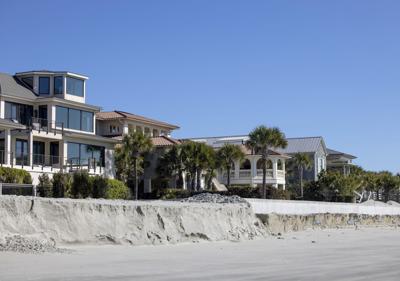ISLE OF PALMS — The emergency ordinance that was adopted to allow beachfront homeowners to build sea walls behind their homes has expired. No walls were built — for now.
No permits were handed out by the city of Isle of Palms to the roughly 100 homeowners who were eligible to build a sea wall or revetment, though they might see another chance this summer.
The emergency ordinance adopted by the city in February, at the urging of property owners near Breach Inlet, gave homeowners a 60-day window to obtain a permit to build a sea wall or revetment behind their homes, under certain conditions.
The walls needed to be installed landward of the state’s Office of Ocean and Coastal Resource Management’s critical area, no more than 20 feet seaward of the city’s maximum build line, and an engineer needed to certify that the wall would not accelerate erosion or harm adjacent properties.
Deputy Town Administrator Douglas Kerr reported to the City Council in April that there were roughly 20 homeowners who were interested in building the walls and had met with OCRM to map out the state’s jurisdiction.
However, homeowners ran into a hiccup in designing the walls — engineers wouldn’t sign a statement ensuring that the walls would not cause damage to adjacent properties or accelerate erosion.
“In an ideal world, the engineers could certify that the wall they’re about to build isn’t going to accelerate erosion or affect others on either side, and they couldn’t do that,” Isle of Palms City Attorney Mac McQuillin told City Council.
Rob Young, a coastal geologist at Western Carolina University, said sea walls may be effective at protecting the property immediately in front of it, but it comes at the expense of the rest of the shore.
“When you have an eroding or a moving shoreline, the sea wall doesn’t really stop the shoreline or the beach from moving, it just doesn’t give it anywhere to go,” Young said. “There’s no such thing as a beach disappearing because of coastal erosion. Beaches disappear if the beach is not able to move landward, and the primary thing that stops the beach from moving landward is the construction of a sea wall.”
Attempts to modify the certification statement, including removing it altogether, were bypassed by City Council, which opted to let the ordinance expire on April 19, 60 days after it was first adopted.
However, the city left the door open to renewing the ordinance, opting to revisit the matter this summer, based on a recent decision from DHEC’s board.
In order to get a permit from the city, interested homeowners worked with OCRM staff to determine if there was enough space between their homes and the critical area to build the wall. In some cases, the critical area ended within inches of a home’s foundation.
A group of four oceanfront homeowners who did not have enough room to build a sea wall per the emergency ordinance appeared before DHEC’s Board on April 11.
Represented by local attorney Mary Shahid, the board voted to allow those homeowners to plant vegetation behind their properties and have OCRM reassess their jurisdiction in 30 to 60 days in an attempt to bring the state’s jurisdiction seaward.
The Coastal Tidelands and Wetlands Act defines the beach — considered a critical area — as an area that can’t sustain plant life due to periodic wave inundation.
If the homeowners can plant vegetation behind their homes, and it survives, OCRM will reassess its jurisdiction. It’s possible that the homeowner will have more room to build a sea wall.
“The Board crafted a very thoughtful resolution. The Department’s staff implementation of that resolution has caused concern, but with renourishment in the immediate future and the Town’s commitment to dune maintenance, I am hopeful that all impacted properties will be restored,” Shahid said.
Meanwhile, issues surrounding sea walls have reached the state Senate.
Sen. Stephen Goldfinch, R-Georgetown, proposed a budget proviso on April 18 that he said would put a “pause” on OCRM’s ongoing enforcement actions while the department reviews its jurisdictional lines, starting this year.
DHEC reevaluates its setback and baseline along the coast every seven to 10 years. Goldfinch told the Senate Finance Committee that the proviso also directs OCRM to review its enforcement actions from May 2018 using the new setback and baseline.
If a homeowner was determined to have built a sea wall in a critical area by the Administrative Law Court, but the structure is later found to be outside that area based on the upcoming reevaluated lines, the state would be responsible for the homeowner’s attorney fees.
“They deserve some relief because the government has literally deprived them of their property rights for the last five years or so,” Goldfinch told the Senate on April 25.
The Senate approved the budget proviso, which still needs to be adopted by the Statehouse and governor. The amendment was criticized by Sen. Sandy Senn, who said it could leave the state on the hook for millions of dollars.
“This is going to be an extremely expensive measure for the state of South Carolina,” the Charleston Republican said.




